Exact Solutions of the 3D Fractional Helmholtz Equation by Fractional Differential Transform Method
Abstract
In this work, we applied the fractional reduced differential transform method (FRDTM) to find the exact solutions of the three-dimensional fractional Helmholtz equation (FHE) and compared our outcomes with the tenth-order approximate solutions for diverse fractional orders. Different values of fractional derivatives are signified explicitly in three dimensions. Outcomes are denoted in the tables for nonfractional exact and approximate solutions and fractional approximate solutions for different fractional orders. Two examples are given to prove the proficiency of the suggested method, to resolve diverse categories of fractional partial differential equations.
1. Introduction
If the Helmholtz equation models a physical reality, then it must have a unique solution. Helmholtz equation is essential for countless applications in real life. Some of them are as follows: it is used in seismology which is the scientific study of earthquakes and elastic waves, tsunamis, medical imaging, volcanic eruptions, and electromagnetism; in the science of optics, the Gibbs-Helmholtz equation is used in the calculation of changes in enthalpy using the change in Gibbs energy when the temperature is varied at constant pressure; and CHELS, a combined Helmholtz equation-least squares abbreviated as CHELS, this method is used for reconstructing acoustic radiation from an arbitrary object.
Abuasad et al. [2] established exact solutions for two-dimensional FHE using FRDTM. Ghaffar et al. [3] employed a higher-order compact difference (HOC) scheme with uniform mesh sizes in different coordinate directions to discretize a two- and three-dimensional Helmholtz equation. Gupta et al. [4] created the approximate analytical solutions of a multidimensional partial differential equation of Helmholtz equation with space fractional derivatives.
The three-dimensional Helmholtz equation has fascinated the attention of numerous researchers; for instance, Li [5] offered a fast singular boundary method (SBM) for the three-dimensional (3D) Helmholtz equation, Li et al. [6] presented a regularized approach for solving the near-boundary and boundary solutions for 3D Helmholtz equation with wideband wave numbers by the boundary collocation method, and Bespalov et al. [7] examined an adaptive boundary element method for the weakly singular and hypersingular integral equations for the 2D and 3D Helmholtz problem. Wang et al. [8] introduced a new finite difference scheme for solving the Helmholtz equation in polar and spherical coordinates. Qu et al. [9] presented a fast multipole accelerated singular boundary method (SBM) for the solution of the large-scale three-dimensional Helmholtz equation at low frequency.
Fractional derivative (FD) is a generalization of integer derivative, the FD generalizes the order of differentiation from integer to real or even to complex, and a series of phenomena can be defined by FD [10]. There is no doubt that fractional calculus has established an original mathematical method of solution for innumerable applications in diverse branches of sciences [11]. Fractional calculus has played an accurate central part in countless applications, e.g., mechanics, interaction, ecology, finances, and signal and image processing. The main subjects of fractional calculus contain anomalous diffusion, vibration, and control and continuous-time random walk [12]. Recently, several books [13–16] on fractional calculus were available, and in all of them, its history is addressed in one way or another. Podliubny [15] presented a review of several applications that have developed from fractional calculus; for instance, he indicated that the use of fractional derivatives for the mathematical modeling of viscoelastic materials is quite natural. Innumerable forms of fractional derivatives were considered: Riemann-Liouville, Caputo, Hadamard, Erdélyi-Kober, Grünwald-Letnikov, Marchaud, and Riesz are just samples. The greatest often used definitions for the common fractional differ-integral are the Grünwald-Letnikov definition, the Riemann-Liouville, and the Caputo definition. Various techniques were intended for explaining fractional differential equations, for instance, monotone iterative method [17], collocation method [18], auxiliary equation method [19], trapezoidal method [20], exponential rational function method [21], first integral method [22], homotopy analysis method [23], local fractional homotopy perturbation method [24], fractional variational iteration method [25], and modified Laplace decomposition method [26].
Vargas [27] presents a new meshless technique for solving a class of fractional differential equations based on moving least squares. Hashim et al. [28] study a class of second-order delay fractional differential equations with a variable-order Caputo derivative. Alesemi et al. [29] applied a new iterative transform technique and homotopy perturbation transform method to calculate the fractional-order Cauchy-reaction diffusion equation solution. Alesemi et al. [30] presented an HPTM and a VITM for studying the fractional-order nonlinear system of the unsteady flow of a polytropic gas. Iqbal et al. [31] investigated the numerical solution of the Fornberg-Whitham equations, involving fractional-order derivatives. Nonlaopon et al. [32] presented the Elzaki transform decomposition method to solve the time-fractional Swift–Hohenberg equations. Naeem et al. [33] used the new iterative transform method and the HPTM to solve fractional-order equal-width equations. Alshammari et al. [34] proposed residual power series (RPS) to find the numerical solution of a class of fractional Bagley--Torvik problems (FBTP) arising in a Newtonian fluid. Agarwal et al. [35] solved fractional-order parabolic equations using an innovative analytical technique.
In actual applications, due to inhomogeneity, nonlinearities, and general boundary conditions, exact solutions are remarkable in numerous divisions of solid mechanics, physics, motion, and fluid mechanics. Consequently, most scholars are satisfied with the approximate solutions to the problems facing them [36].
FRDTM was announced by Keskin and Oturanc [37] to generalize the reduced differential transform method (RDTM) from integer to fractional differential equations, which is a general method of differential transform method (DTM) to decrease the complexity and computations. FRDTM involves four core steps: first of all, we have to find the fractional reduced transformed function, then find the inverse of a fractional reduced transformed function, after that find the approximate solution, finally with the help of some special functions we try to find the exact solution. These four steps will be enlightened in detail in Section 3. Abuasad et al. [38] presented a novel modification called m-FRDTM to catch the solutions for MT-TFDEs.
Saravanan and Magesh [39] linked two analytical methods: FRDTM vs fractional variational iteration method (FVIM) to catch numerical solutions of the linear and nonlinear Fokker-Planck partial differential equations with space and time-fractional derivatives. Arshad et al. [40] presented a general form of FRDTM to solve wave-like problems, Zakharov–Kuznetsov equation, and couple BE. Abuasad et al. [41] obtained the exact and approximate solutions of higher-dimensional time-fractional diffusion equations using FRDTM.
The significance of this study is obtaining the exact solution for the 3D factional Helmholtz equation by a comparatively original technique and matching the exact solutions of non-FHE with the tenth-order approximate solutions for diverse values of the fractional derivatives. The different thing in this study is the description of FRDTM for three-dimensional FHE with modest and successive steps,; thus, this research can be used as a basic reference for researchers to understand this method and apply it in different applications to obtain exact and approximate solutions in very simple steps. This study is scheduled as providing simple definitions and properties of fractional calculus in Section 2. Section 3 presents the suggested method, while Section 4 offers the exact solutions of two examples of 3D FHE. We close the paper in Section 5 by main results.
2. Basic Definitions
2.1. Caputo Fractional Derivative
3. FRDTM for 3 Variables
| Original function | T-function |
|---|---|
| 1. f = c1u ± c2v | Fαk = c1Uαk ± c2Vαk |
| 2. f = uv |
|
| 3. | Fαk = (Γ(α(k + m) + 1)/Γ(kα + 1))Uα(k + m) |
| 4. | , i = 1, 2, ⋯, n |
| 5. | , i = 1, 2, ⋯, n |
| 6. | , i = 1, 2, ⋯, n |
4. Computational Illustrations
To show the efficiency of this method, we consider two homogeneous fractional 3D-Helmholtz equations subject to appropriate initial conditions (I.C.). We can find the exact solutions with the help of some special functions. The exact and approximate solutions for fractional and nonfractional 3D-Helmholtz equations are represented numerically and graphically for different values of the fractional order (α) to show the importance and effectiveness of the proposed method.
4.1. First Application
Table 2 presents the numerical solutions for u10(x, y, z) by FRDTM at different values of α and a comparison of absolute errors at α = 2 for FRDTM between exact solution and tenth-order approximate solution. Figure 1 depicts the three-dimensional exact and the tenth-order approximate solution of FRDTM for nonfractional order (α = 2), while Figure 2 depicts the approximate solutions of FRDTM for α = 1.8 and α = 1.4. Figures 3 and 4 depict the absolute error between the exact solution and tenth-order approximate solutions for different values of α; we note that the absolute error between the tenth-order approximate solutions and the exact solution becomes small as alpha becomes large: approximately less than 4 × 10−8 when α = 1 and less than 8 × 10−16 when α = 2.
| x | Nonfractional order (α = 2) | Fractional order | |||||
|---|---|---|---|---|---|---|---|
| z | uExact | u10 | |uExact − u10| | α = 1.6 | α = 1.4 | α = 1.2 | |
| 0.2 | 0.2 | 0.714047 | 0.714047 | 0 | 0.737811 | 0.760876 | 0.797191 |
| 0.5 | 0.789338 | 0.789338 | 1.11022e − 16 | 0.87164 | 0.936162 | 1.02565 | |
| 0.8 | 0.936204 | 0.936204 | 1.11022e − 16 | 1.08973 | 1.20119 | 1.35002 | |
| 0.5 | 0.2 | 1.02007 | 1.02007 | 0 | 1.05402 | 1.08697 | 1.13884 |
| 0.5 | 1.12763 | 1.12763 | 0 | 1.2452 | 1.33737 | 1.46522 | |
| 0.8 | 1.33743 | 1.33743 | 0 | 1.55675 | 1.71599 | 1.9286 | |
| 0.8 | 0.2 | 1.32609 | 1.32609 | 2.22045e − 16 | 1.37022 | 1.41306 | 1.4805 |
| 0.5 | 1.46591 | 1.46591 | 0 | 1.61876 | 1.73859 | 1.90478 | |
| 0.8 | 1.73867 | 1.73867 | 2.22045e − 16 | 2.02378 | 2.23079 | 2.50718 | |
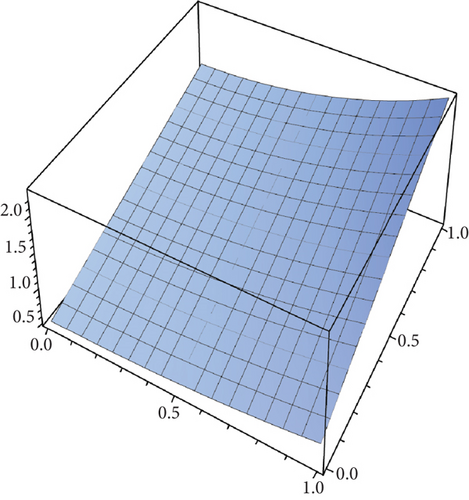
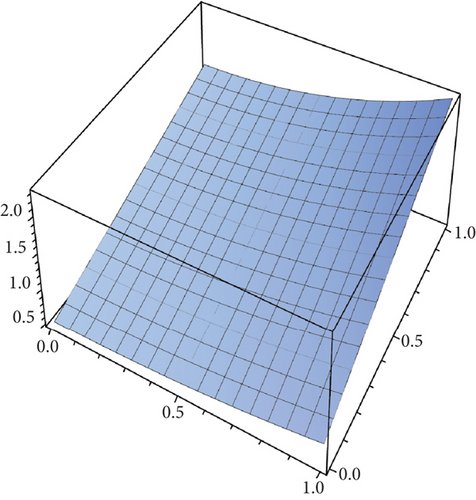
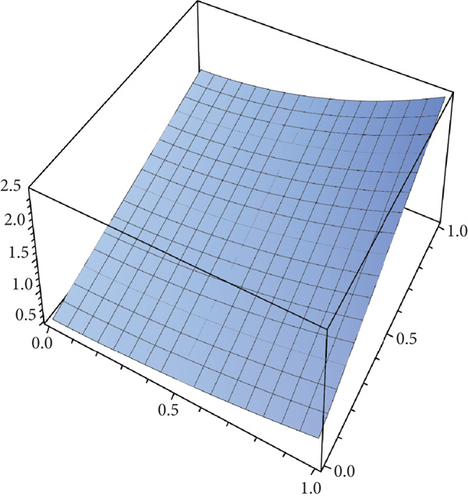
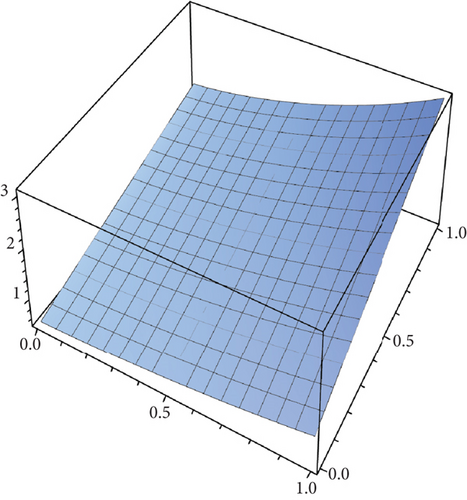
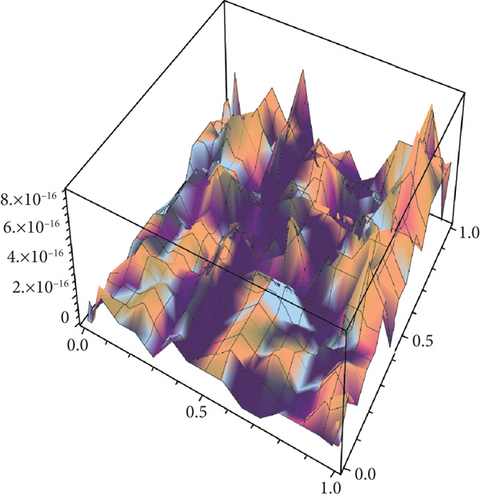
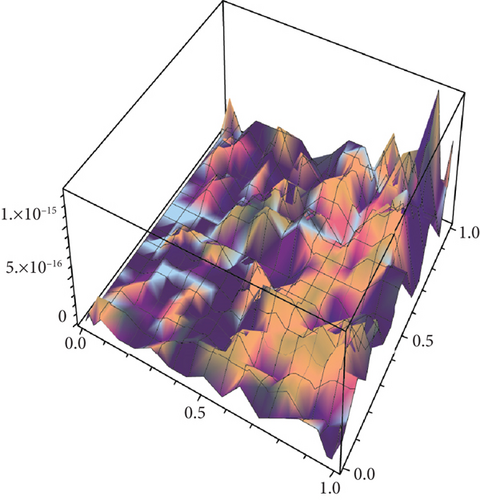
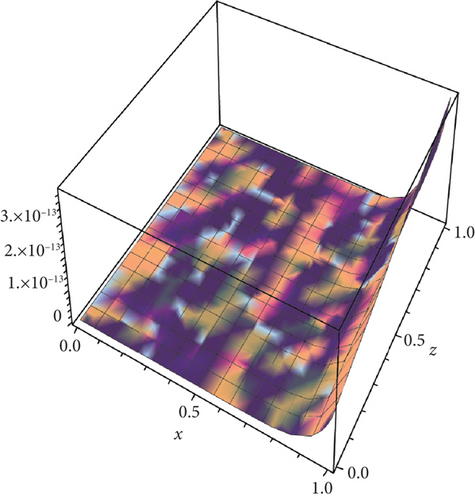
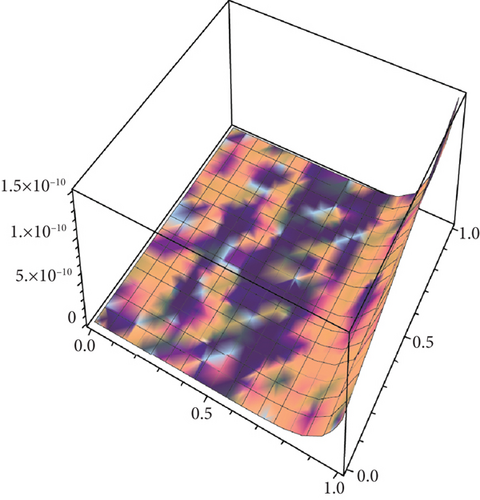
4.2. Second Application
Table 3 shows the numerical solutions for u10(x, y, z) by FRDTM at different values of α and a comparison of absolute errors at α = 2 for FRDTM between the exact solution and tenth-order approximate solution. Figure 5 depicts the three-dimensional exact and the tenth-order approximate solution of FRDTM for nonfractional order (α = 2). Figure 6 represents the approximate solutions of FRDTM for α = 1.8 and α = 1.4. Figures 7 and 8 depict the absolute error between the exact solution and tenth-order approximate solutions for different values of α; we note that the absolute error between the tenth-order approximate solutions and the exact solution becomes small as alpha becomes large: approximately less than 4 × 10−8 when α = 1 and less than 8 × 10−16 when α = 2.
| x | Nonfractional order (α = 2) | Fractional order | |||||
|---|---|---|---|---|---|---|---|
| z | uExact | u10 | |uExact − u10| | α = 1.8 | α = 1.4 | α = 1.2 | |
| 0.2 | 0.2 | 0.631159 | 0.631159 | 0 | 0.588705 | 0.442158 | 0.345033 |
| 0.5 | 0.306216 | 0.306216 | 5.55112e − 17 | 0.200098 | 0.0445607 | 0.0345265 | |
| 0.8 | -0.151434 | -0.151434 | 2.77556e − 16 | -0.209474 | -0.130004 | -0.0476061 | |
| 0.5 | 0.2 | 0.901656 | 0.901656 | 0 | 0.841007 | 0.631655 | 0.492904 |
| 0.5 | 0.437451 | 0.437451 | 5.55112e − 17 | 0.285854 | 0.0636582 | 0.0493236 | |
| 0.8 | -0.216334 | -0.216334 | 0 | -0.299248 | -0.18572 | -0.0680088 | |
| 0.8 | 0.2 | 1.17215 | 1.17215 | 0 | 1.09331 | 0.821151 | 0.640775 |
| 0.5 | 0.568687 | 0.568687 | 0 | 0.37161 | 0.0827556 | 0.0641206 | |
| 0.8 | -0.281234 | -0.281234 | 5.55112e − 16 | -0.389023 | -0.241436 | -0.0884114 | |
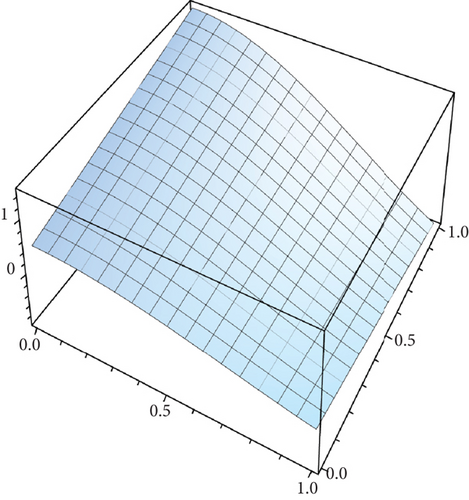

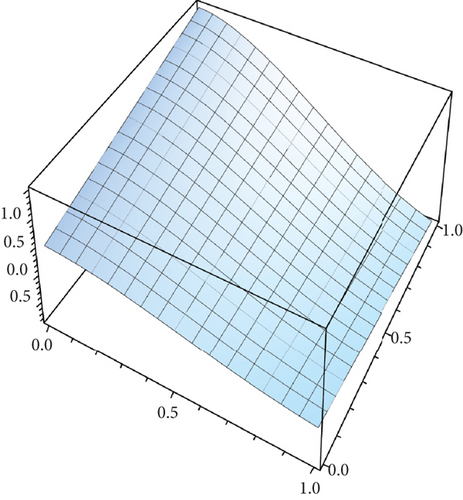
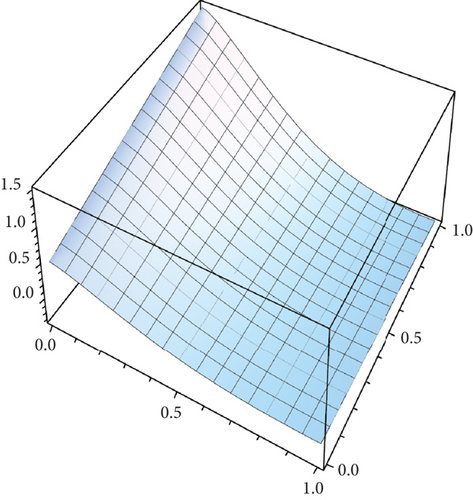
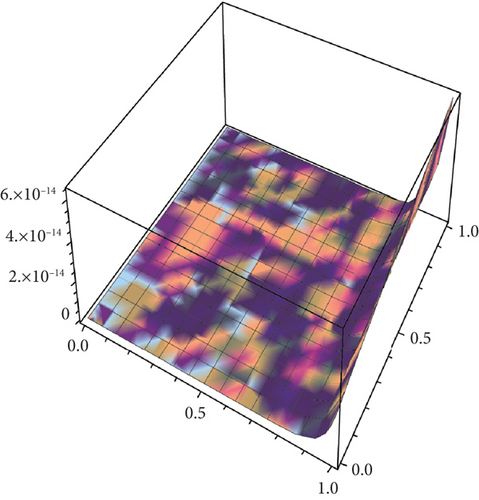
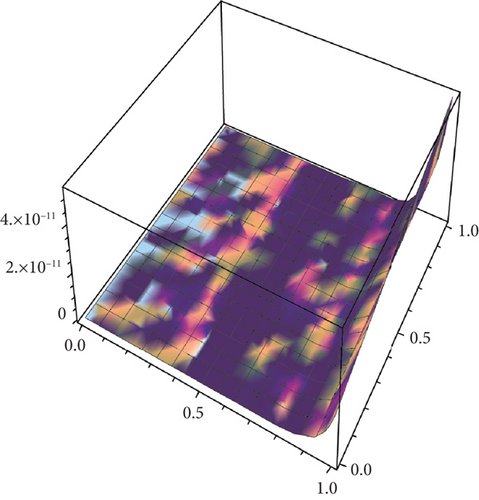
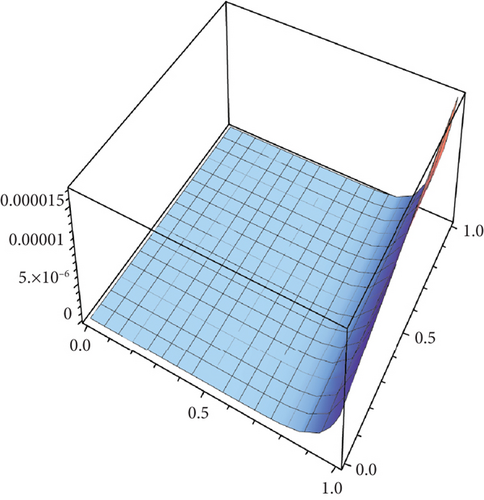

5. Conclusion
In brief, the exact solution of the 3D FHE has been established via FRDTM. In the introduction, the definition of the Helmholtz equation and its most vital applications in science were offered. After that, the fractional derivatives were discussed, and the most essential research and methods used to solve the fractional differential equations are presented. Then, the significance of the research and its features was debated. The method for three variables was submitted in a simplified manner, and then, this method was applied to two homogeneous 3D-FHE subjects to proposed initial conditions.
This method is a very effective approach for resolving diverse categories of fractional partial differential equations in different dimensions and finding exact solutions not only approximate solutions gives this method a significant advantage over other methods of solving fractional differential equations.
Conflicts of Interest
The authors declare that they have no conflicts of interest.
Acknowledgments
The authors would like to thank the Deanship of Scientific Research, the University of Ha’il for supporting this work. This work has been supported by Scientific Research Deanship at the University of Ha’il-Ha’il, Saudi Arabia, through project number BA-2124.
Open Research
Data Availability
The datasets used and analyzed during the current study are available from the corresponding author on reasonable request.




